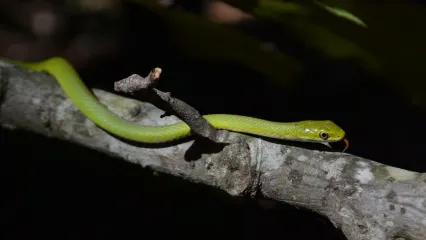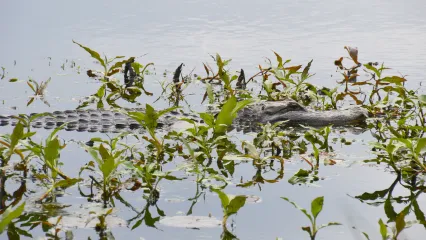
Description
Timber rattlesnakes are large, heavily-bodied pit-vipers and have a large, distinctive rattle on the tail and a black, velvety colored tail. Dorsal scales are heavily keeled and scales under the tail are not divided as in most non-venomous snakes. Because of the distinctive black tail, these snakes are often called “velvet tails.” Background color of the body is gray to ash gray and an orange or orange-red line about 3 – 6 scales wide extends on the top of the body from the back of the head to the tail. Black bands run down the entire body to the tail, and from above, each band appears to form a “v.” Viewed from the side, the bands appear more irregular (zig-zagged) and may or may not connect with a parallel series of lateral black blotches. The underside of the body is cream-colored. The only remotely similar snake is the western pygmy rattlesnake, which is much smaller in size (usually less than two feet in total length), has spots rather than cross bands, and has a very small rattle. Western pygmy rattlesnakes do have an orange to red-orange midline. Close examination on the top of the head will reveal tiny scales on the western pygmy rattlesnake and large scales on timber rattlesnakes.
Size
Large adult timber rattlesnakes can reach more than five feet in total length, but individuals exceeding four feet are uncommon. Newborn young are about twelve inches in total length.
Habitat
The west to east distribution of timber rattlesnakes in the United States extends from central Oklahoma nearly to Maine, and north to south from northern New York to central-east Texas.
Life Cycle
Timber rattlesnakes live in forested areas that have rocky outcrops. They are primarily terrestrial but, like many other snakes, they can swim and individuals have been observed off the ground in shrubs. During late fall, timber rattlesnakes migrate to dens, usually in crevices in rocky outcrops, where they spend the winter. In late fall and early spring, several individuals can be found basking near the entrances of den sites. In April, timber rattlesnakes often enter grassy fields in search of small mammals. During spring and fall, these snakes are diurnal, but become nocturnal during summer. They often lie coiled under leaf litter for extended periods during summer. Timber rattlesnakes feed largely on small mammals and birds, and like other pit-vipers, can detect prey with their infra-red heat sensory organs (pits). Large adults often eat seemingly huge prey (gray and fox squirrels), and it is not unusual to find one of these snakes lying on the forest floor in the shade with such a huge lump in the stomach that the snake cannot coil. Like other pit-vipers, timber rattlesnakes are late maturing, long-lived, and reproduce repeatedly. Sexual maturity is not reached until at least the fourth year of life, and in many individuals, 6 – 7 years may be required. Although maximum life span remains unknown, individuals can live for at least 25 years. Females generally do not reproduce each year, producing litters of live young every other year, every third year, or in some cases, every fourth year. Females produce litters varying from seven to 11 young, with larger females producing larger litters. Newborn snakes appear in late August and early September.
How To Observe
Timber rattlesnakes are most easily observed in spring and early summer when they move around. They can be found on the forest floor, basking at the edge of crevices in rocks, and inside of crevices. During spring and fall, these snakes can occasionally be found at night crossing or basking on warm roads. It is critical to keep in mind that timber rattlesnakes are highly venomous and should not be handled or disturbed.
(This profile was created by Dr. Laurie Vitt as part of a partnership between the Wildlife Department and the Sam Noble Oklahoma Museum of Natural History. It was funded as part of a larger State Wildlife Grant to survey and inventory amphibians and reptiles of the Wildlife Management Areas of Oklahoma: T-35-P-1.)


